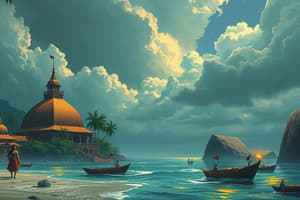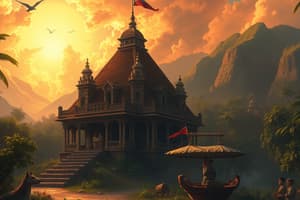Podcast
Questions and Answers
What year did Spanish colonization in the Philippines begin?
What year did Spanish colonization in the Philippines begin?
- 1545
- 1565 (correct)
- 1610
- 1580
Which of the following was a significant economic activity introduced by the Spanish during their colonization?
Which of the following was a significant economic activity introduced by the Spanish during their colonization?
- Mining
- Rice agriculture (correct)
- Fishing
- Textile production
Who acted as the king's representative in the centralized colonial government established by Spain?
Who acted as the king's representative in the centralized colonial government established by Spain?
- The Viceroy
- The local chief
- The Governor-General (correct)
- The Council of the Indies
Which major religious order was NOT involved in spreading Catholicism during the Spanish colonization?
Which major religious order was NOT involved in spreading Catholicism during the Spanish colonization?
The galleon trade linked which two locations during the Spanish colonization?
The galleon trade linked which two locations during the Spanish colonization?
What social class emerged in the Philippines during Spanish colonization?
What social class emerged in the Philippines during Spanish colonization?
Which event marked the beginning of the push for independence from Spanish rule?
Which event marked the beginning of the push for independence from Spanish rule?
Which of the following movements emerged in response to Spanish colonization in the late 19th century?
Which of the following movements emerged in response to Spanish colonization in the late 19th century?
What is the primary focus of the CENACULO performance?
What is the primary focus of the CENACULO performance?
Which of the following best describes the Lagaylay event?
Which of the following best describes the Lagaylay event?
What does the Panunuluyan presentation depict?
What does the Panunuluyan presentation depict?
In what context is the Karagatan performance usually held?
In what context is the Karagatan performance usually held?
What is the main structure of a Zarzuela?
What is the main structure of a Zarzuela?
What significant change in the Filipino educational system occurred during Spanish colonization?
What significant change in the Filipino educational system occurred during Spanish colonization?
How did the Spanish language influence Filipino culture during colonization?
How did the Spanish language influence Filipino culture during colonization?
Which cultural practices were adopted by Filipinos during the Spanish colonization?
Which cultural practices were adopted by Filipinos during the Spanish colonization?
What was the first book printed in the Philippines and what did it primarily consist of?
What was the first book printed in the Philippines and what did it primarily consist of?
What social change resulted from the influence of Spanish colonization over Filipinos?
What social change resulted from the influence of Spanish colonization over Filipinos?
Flashcards are hidden until you start studying
Study Notes
Spanish Colonization
-
Duration: 1565 - 1898
-
Initial Contact:
- Ferdinand Magellan arrived in 1521; claimed the islands for Spain.
- Spanish colonization formally began in 1565 with Miguel López de Legazpi.
-
Government Structure:
- Established a centralized colonial government.
- Governor-General acted as the king's representative.
- Local governance through encomiendas: land grants to Spanish settlers with control over indigenous labor.
-
Religious Influence:
- Spread of Roman Catholicism; establishment of missions and churches.
- Major religious orders: Augustinians, Franciscans, Jesuits, Dominicans.
- Conversion of indigenous populations significantly altered social and cultural dynamics.
-
Economy:
- Introduction of agriculture: rice, sugarcane, and tobacco became key crops.
- Galleon trade initiated in 1565, linking Manila with Acapulco, Mexico.
- Economic exploitation and forced labor led to significant social inequalities.
-
Societal Changes:
- Class system emerged: Spanish mestizos, indios (natives), and insulares (Spanish born in the Philippines).
- Spanish language and culture deeply influenced local customs and practices.
- Education system established, primarily focused on religious instruction.
-
Resistance and Revolts:
- Frequent uprisings against Spanish rule, e.g., the Dagohoy Rebellion (1744-1829) and the Silang Revolt (1762).
- Nationalism began to develop in the late 19th century, leading to the rise of reformist movements.
-
End of Spanish Rule:
- The Philippine Revolution (1896-1898) marked the push for independence.
- Spanish-American War (1898) resulted in the defeat of Spain and the Treaty of Paris ceded the Philippines to the U.S.
Duration and Initial Contact
- Spanish colonization spanned from 1565 to 1898.
- Ferdinand Magellan claimed the Philippines for Spain in 1521, marking initial European contact.
- Miguel López de Legazpi initiated formal colonization in 1565.
Government Structure
- Centralized colonial government implemented, with a Governor-General acting as the king's representative.
- Local governance was organized through encomiendas, granting land to Spanish settlers who controlled indigenous labor.
Religious Influence
- Roman Catholicism was spread widely, with significant missions and churches established.
- Major religious orders included Augustinians, Franciscans, Jesuits, and Dominicans.
- Conversion efforts led to profound changes in indigenous social and cultural dynamics.
Economy
- Agriculture was transformed with key crops like rice, sugarcane, and tobacco introduced.
- The Galleon trade, starting in 1565, connected Manila with Acapulco, Mexico, enhancing economic ties.
- Significant social inequalities arose due to economic exploitation and the use of forced labor.
Societal Changes
- A class system developed, categorizing people into Spanish mestizos, indios (natives), and insulares (Spaniards born in the Philippines).
- Spanish language and cultural practices significantly impacted local customs and lifestyles.
- An education system was established, primarily focusing on religious education.
Resistance and Revolts
- Numerous uprisings against Spanish colonial rule occurred, including the Dagohoy Rebellion (1744-1829) and the Silang Revolt (1762).
- Nationalism began to grow in the late 19th century, spurring the emergence of various reformist movements.
End of Spanish Rule
- The Philippine Revolution (1896-1898) was pivotal in the fight for independence from Spanish rule.
- The 1898 Spanish-American War resulted in Spain's defeat and led to the Treaty of Paris, which ceded the Philippines to the United States.
Spanish Colonization of the Philippines
- Spanish colonization began in 1565 with Miguel Lopez de Legazpi as the first governor-general.
- Literature flourished during this period, lasting until the Cavite Revolt in 1872.
- The Philippines was colonized by Spain for over three centuries, leading to significant changes in Filipino life.
Cultural Changes Under Spanish Rule
- Filipinos embraced Catholicism, altered their names, and received baptisms.
- Lifestyle transformations included the construction of stone and brick houses and the use of ornate furniture and utensils.
- Transportation evolved with the introduction of carriages, trains, and boats.
- Cultural celebrations such as fiestas were held to honor saints, the pope, and governors, alongside recreational activities like cockfights and horse races.
Social Structure and Education
- The colonization gave rise to distinct social classes, including the wealthy and landlords.
- Some Filipinos pursued higher education in fields like medicine, law, and teaching, benefiting from newly established schools.
Linguistic and Literary Influences
- The Roman alphabet replaced the original Filipino alphabet, known as “alibata.”
- Christian Doctrine teaching influenced religious practices and incorporated Spanish vocabulary into Filipino languages.
- European legends and traditions were integrated into local songs, corridos, and moro-moros.
- Ancient literary works were collected and translated into Tagalog and other Filipino dialects, with grammar books printed in various regional languages.
Notable Literary Works
- Ang Doktrina Cristiana: The first printed book in the Philippines in 1593 through xylography, establishing religious literature.
- Nuestra Señora del Rosario: The second printed book (1602) by Fr. Blancas de San Jose at UST Printing Press.
- PASYON: A narrative poem detailing the life of Jesus Christ from birth to death.
Folk and Religious Performances
- Balagtasan: A poetic contest focusing on debating skills on various topics.
- CENACULO: Dramatization of the Passion of Christ, performed during the Lenten season.
- Panunuluyan: A Christmas Eve presentation illustrating Mary and Joseph's search for shelter before the birth of Jesus.
- Salubong: An Easter play showing the reunion of the risen Christ with his mother.
- Carillo (Shadow Play): Dramatic performances held during town fiestas or on dark nights post-harvest.
- Zarzuela: Musical comedies addressing various human emotions and social issues.
- Karagatan: A socio-religious poetic expression celebrated during funerals.
- TIBAG: A reenactment of St. Helena’s search for the Holy Cross.
Studying That Suits You
Use AI to generate personalized quizzes and flashcards to suit your learning preferences.




